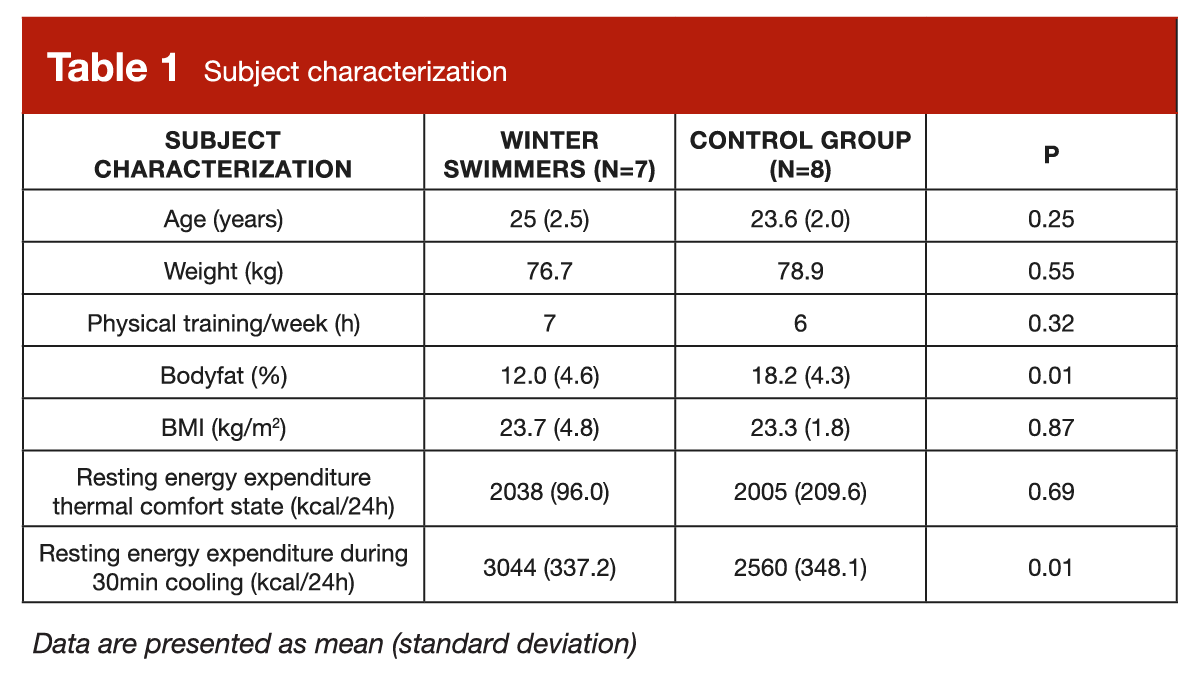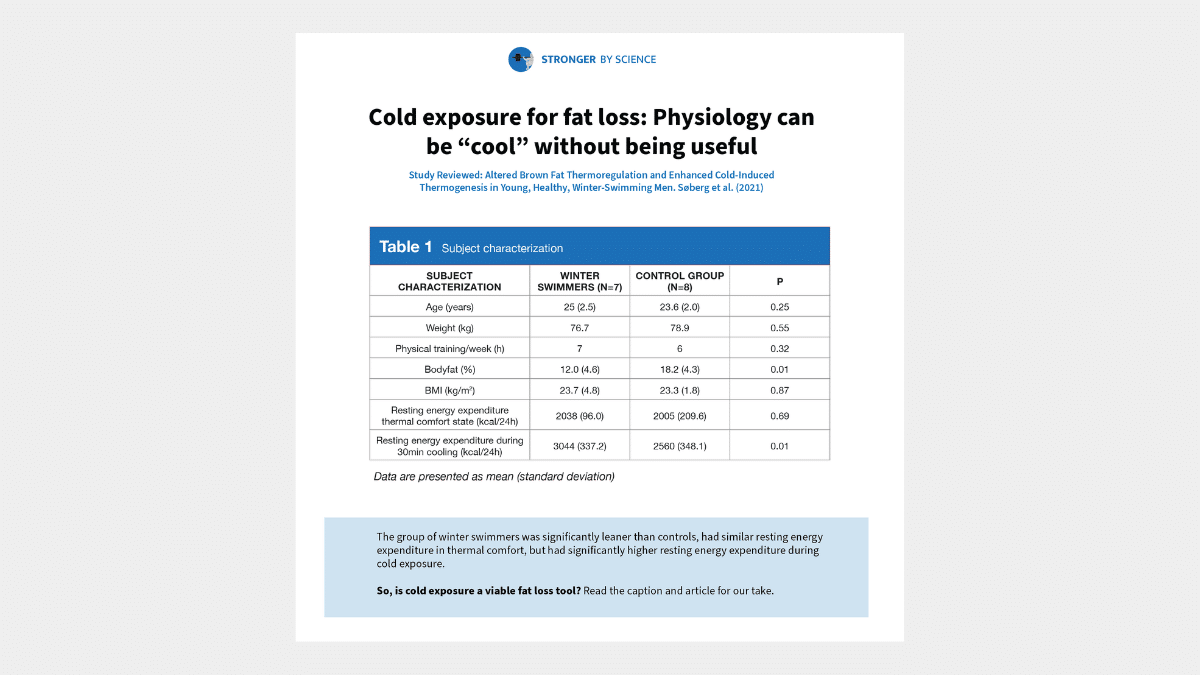I assume we can generally agree that science is pretty cool. A positive aspect of this perspective is that we can embrace rigorous scientific principles and use them to optimize our habits and practices related to training, nutrition, and other health behaviors. There is, however, a potential drawback of this perspective. If we get a little too enthusiastic about how cool science is, we can sometimes get too enamored with fascinating aspects of human physiology. If we aren’t careful, we can get sucked into overhyped concepts that encourage us to put the cart before the horse (i.e., apply an intriguing intervention before we have evidence to suggest that it’s actually applicable). Not everything that is fascinating is actionable, and not everything that is actionable is fascinating.
That brings us to the concept of cold exposure. I’m not talking about cold water immersion (MASS subscription required to view article) to reduce inflammation following exercise or acute tissue injury, but simply exposing your body to cold conditions (usually in the form of water immersion, since water facilitates heat transfer so efficiently) to obtain a long list of other extremely speculative benefits. One of the purported outcomes most frequently discussed is increased energy expenditure and fat oxidation, which has caused some fairly notable figures to suggest that frequent cold exposure is an effective way to facilitate fat loss.
The idea is that cold exposure will acutely increase sympathetic nervous system activity, shivering, and brown adipose tissue activation. Sympathetic nervous system activation induces a neuroendocrine response that increases energy expenditure and fat oxidation, and shivering increases energy expenditure via increased muscle activity. You may be less familiar with brown adipose tissue because, until fairly recently, the prevailing belief was that adult humans typically had a negligible amount of this tissue. However, research over the last 10-20 years has indicated that adult humans do have clusters of brown adipose tissue, and that this tissue is stimulated by cold exposure. Upon stimulation, brown adipose cells (which are rich in mitochondria) ramp up their metabolic rate for the purpose of generating heat. So, energy expenditure and fat oxidation are acutely increased due to these impacts on the sympathetic nervous system, shivering, and brown adipose tissue activation, but chronic effects are also likely. For example, there is some evidence that individuals who spend a lot of time in cold environments have upregulated brown adipose tissue activity, and that some of their white adipose tissue (i.e., “normal” subcutaneous fat) starts looking and behaving more like brown adipose tissue. This semi-converted fat is often referred to as “beige” adipose tissue, and the potential to intentionally induce this conversion has spurred interest in studying chronic cold exposure.
That’s where the presently reviewed study comes into play. Briefly, the researchers were interested in comparing a huge list of physiological characteristics and responses in “winter-swimming men” and a control group matched based on age, gender, BMI, and physical activity level. Two to three times per week, participants engaged in a form of winter swimming that involved a combination of brief immersion in very cold water and hot sauna bathing, which appears to be popular in some Scandinavian countries. The researchers measured a ton of different outcomes, but the most relevant (for our purposes) relate to energy expenditure and brown fat activity. In short, the researchers measured resting energy expenditure in a thermal comfort state (comfortable ambient temperature) and during a 30-minute cooling condition (which aimed to keep participants just slightly above the shivering threshold).
In the interest of staying true to the “brief” aspect of the research briefs section, I’ll skip right to the point. As shown in Table 1, the group of winter swimmers was significantly leaner than controls (12.0 versus 18.2% body-fat), had similar resting energy expenditure in thermal comfort (2,038 versus 2,005 kcal/day), but had significantly higher resting energy expenditure during cold exposure (3,044 versus 2,560 kcal/day).

It seems that a recent resurgence of interest in cold-water immersion for fat loss purposes has been fueled, to a large extent, by a prominent podcast that sometimes covers fitness-related topics. In the linked episode, the presenter suggests that cold water immersion is a viable fat loss tool, but that you should be mindful not to adapt to it because of anecdotes involving cold-water swimmers with high body-fat levels. This anecdotal evidence was perceived to indicate that adapting to cold-water immersion would diminish the effects related to energy expenditure and fat loss. The presently reviewed study directly contradicts these recommendations; winter swimmers tended to be leaner than well-matched controls, and had more robust thermogenic responses to cold exposure.
More importantly, I’d like to focus on the most practical aspect of this topic: whether or not cold exposure is a viable fat loss target. The presently reviewed study reported cold-induced increases in energy expenditure of nearly 50% (relative to thermoneutral energy expenditure), but this is far from the norm. Other studies often report values around the 15% range, with a high degree of variability from person to person. In addition, it’s critical to recognize that this is the elevation observed during cold exposure; if you increase your resting metabolic rate by 250 kcal/day, but you only engage in one hour of cold exposure, you’re talking about an absolute increase of less than 11kcal (in other words, an entirely negligible amount). You could argue that this magnitude underestimates the true value of cold water immersion, because these studies use temperatures just above the shivering threshold, which is intended to exclusively quantify the impact of brown adipose tissue activity in the absence of shivering-induced energy expenditure. However, this implies that in order for the intervention to have any hope of producing a meaningful effect, it must be applied in a manner that is impractical and tremendously uncomfortable.
My skepticism is comprehensively echoed in a recent review paper by Marlatt and colleagues. The highlights of their paper include the observations that “studies in humans do not support the hypothesis that induction and activation of [brown adipose tissue] may be an effective strategy for body weight control,” cold-induced increases in energy expenditure likely lead to compensatory increases in appetite, and there is no evidence of seasonal body composition changes that would link colder conditions to reductions in body weight or fat mass. In short, there is little reason to believe that any practical and tolerable implementation of cold exposure will lead to meaningful body composition changes. In addition, unaccustomed cold water exposure can lead to severe adverse cardiovascular complications, so these types of interventions should be approached with extreme caution. We must always be skeptical of “sciency” interventions that are driven by mechanisms, anecdote, or intuition. Learning about science is always encouraged, but remember: not everything that is fascinating is actionable, and not everything that is actionable is fascinating. We’ve got plenty of boring strategies to effectively support body composition goals; physiological responses to acute and chronic cold exposure are really cool, but their relevance to fat loss is dubious at best.
This Research Spotlight was originally published in MASS Research Review. Subscribe to MASS to get a monthly publication with breakdowns of recent exercise and nutrition studies.
Credit: Graphics by Kat Whitfield.




